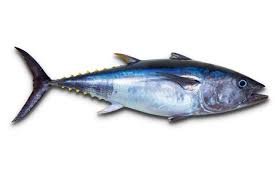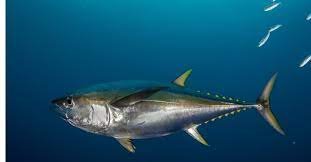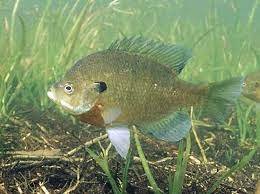Yellowfin Tuna Facts, FAQs, Behaviour, Habitat, Conservation and More

Yellowfin Tuna Facts | Description | Distribution and Habitat | Conservation | Behaviour and Ecology | Interaction with Human | Cultural | Interesting facts | frequently asked questions about Yellowfin Tuna
Looking for a delicious and nutritious seafood option? Look no further than the Yellowfin Tuna! With its firm texture and rich, meaty flavor, this fish is a favorite among seafood lovers worldwide. Not only is it a tasty addition to any meal, but Yellowfin Tuna is also packed with protein and essential omega-3 fatty acids, making it a healthy choice for those looking to maintain a balanced diet. Whether grilled, seared, or served raw in sushi, the Yellowfin Tuna is a versatile and flavorful fish that is sure to please. So why wait? Dive into the world of Yellowfin Tuna today and experience the taste of the ocean like never before!
Taxonomy of Yellowfin Tuna
| Kingdom | Animalia |
|---|---|
| Phylum | Chordata |
| Class | Actinopterygii |
| Order | Perciformes |
| Family | Scombridae |
| Genus | Thunnus |
| Species | Thunnus albacares |
Morphology of Yellowfin Tuna
| Morphological Feature | Description |
|---|---|
| Body Shape | Streamlined and fusiform, tapered at both ends |
| Body Size | Average length of 1.5 meters, weighing up to 200 kilograms |
| Fins | Two dorsal fins, one anal fin, and two pectoral fins |
| Scales | Minute, embedded in the skin, and difficult to see |
| Coloration | Dark metallic blue on the upper body, fading to silver on the lower body with yellow finlets |
| Eyes | Large and round, with a golden iris |
| Mouth | Large and wide, with sharp teeth |
| Swim Bladder | Large and well-developed, providing buoyancy |
| Gills | Four pairs of gills, covered by a bony plate called an operculum |
| Lateral Line | Visible as a series of small pores along the sides of the body |

Description of Yellowfin Tuna
The Yellowfin Tuna, or Thunnus albacares, is a large predatory fish that inhabits the tropical and subtropical waters of the world’s oceans. It is a member of the Scombridae family, which also includes other popular tuna species such as the Bluefin and the Skipjack.
The Yellowfin Tuna has a streamlined and fusiform body shape that tapers at both ends, making it an excellent swimmer. It can grow up to an average length of 1.5 meters and weigh up to 200 kilograms. The body is covered in minute scales that are embedded in the skin and difficult to see.
The coloration of the Yellowfin Tuna is striking, with a dark metallic blue on the upper body that fades to silver on the lower body, complemented by bright yellow finlets. The eyes are large and round, with a golden iris, while the mouth is wide and equipped with sharp teeth.
The Yellowfin Tuna has two dorsal fins, one anal fin, and two pectoral fins that enable it to maintain stability and maneuverability in the water. It also has a well-developed swim bladder that provides buoyancy.
The gills of the Yellowfin Tuna are covered by a bony plate called an operculum, and there are four pairs of gills that extract oxygen from the water. The lateral line, which runs along the sides of the body, is visible as a series of small pores.
In summary, the Yellowfin Tuna is a stunningly beautiful and powerful fish with a streamlined body shape, striking coloration, and a large set of sharp teeth. Its fins and swim bladder make it a superb swimmer, while its gills extract oxygen from the water. The Yellowfin Tuna is an impressive example of marine life that continues to captivate people worldwide.
Distribution and habitat of Yellowfin Tuna
The Yellowfin Tuna is a warm-water species that inhabits the tropical and subtropical waters of the world’s oceans. Its distribution ranges from the eastern Pacific Ocean, through the Indian Ocean and into the western Pacific Ocean, as well as the waters around the Mediterranean Sea.
Within its range, the Yellowfin Tuna is found in a variety of habitats, including the open ocean, nearshore waters, and around reefs and seamounts. It prefers water temperatures between 18-30 degrees Celsius and is often found in areas with strong ocean currents.
Yellowfin Tuna is a highly migratory species that undertakes long-distance movements in search of suitable feeding and breeding grounds. In the eastern Pacific, for example, Yellowfin Tuna migrate northward during the summer months, following the warmer waters, and southward during the winter months, following the cooler waters.
In addition to its natural range, the Yellowfin Tuna has been introduced to various regions worldwide, including the eastern Pacific Ocean, the Caribbean Sea, and the Gulf of Mexico, where it has established self-sustaining populations.
Overall, the Yellowfin Tuna’s distribution and habitat are diverse, allowing it to thrive in a range of marine environments and supporting its role as an important predator in the ocean food web.
Behaviour and Ecology of Yellowfin Tuna
The Yellowfin Tuna is a highly migratory and schooling species that exhibits complex social behavior. Schools of Yellowfin Tuna can consist of thousands of individuals, and individuals within a school often exhibit synchronized movements and swimming patterns.
Yellowfin Tuna are active predators that feed on a variety of prey, including small fish, squid, and crustaceans. They use their keen eyesight and lateral line system to detect prey, and their large, powerful bodies to chase and capture it.
Due to their large size and high trophic level, Yellowfin Tuna are an important predator in the ocean food web, and they are preyed upon by a variety of marine mammals and sharks.
Reproductive behavior in Yellowfin Tuna is complex and involves the formation of spawning aggregations. These aggregations occur in deep waters, and males and females engage in courtship behaviors, culminating in the release of eggs and sperm into the water column.
The Yellowfin Tuna’s migration patterns are closely tied to water temperatures and ocean currents, and they can travel vast distances in search of suitable feeding and breeding grounds. This makes them an important species for commercial and recreational fisheries, and their populations are carefully managed to ensure their sustainability.
Overall, the Yellowfin Tuna’s behavior and ecology are shaped by their role as a predator in the ocean food web, and their complex social behavior and migration patterns make them a fascinating species to study and observe.
Conservation of Yellowfin Tuna
- Harvest quotas: Governments and fishery management organizations set annual catch limits to ensure that the overall harvest of Yellowfin Tuna remains sustainable.
- Gear restrictions: Regulations are in place to limit the use of certain fishing gear, such as longlines and purse seines, that have a high bycatch of non-target species.
- Size limits: Minimum size limits are imposed to allow immature individuals to reach reproductive age before being harvested.
- Closed areas and seasons: Certain areas and seasons are closed to fishing to protect Yellowfin Tuna spawning aggregations and to prevent overfishing.
- Monitoring and enforcement: Fishery managers monitor catch levels and enforce regulations to ensure compliance and prevent illegal fishing.
Interaction with Human of Yellowfin Tuna
- Yellowfin Tuna is an important fish species that is highly valued for its meat and is a staple of many commercial and recreational fisheries around the world. As a result, Yellowfin Tuna has significant interactions with humans, both positive and negative.
- On the positive side, the Yellowfin Tuna fishery supports livelihoods and provides a source of protein for millions of people worldwide. It is an important export commodity, particularly for developing countries, and it contributes to the global economy.
- However, the overfishing of Yellowfin Tuna populations has led to concerns about the sustainability of the fishery. Some populations have declined to the point where they are considered overexploited, and conservation measures have been implemented to address this issue.
- In addition, Yellowfin Tuna populations are vulnerable to bycatch in other fisheries, such as those targeting sharks and billfish, and to habitat destruction caused by bottom trawling and other destructive fishing practices.
- Yellowfin Tuna populations are also threatened by climate change, which is affecting their distribution and migration patterns as ocean temperatures and currents shift.
- Overall, the interactions between Yellowfin Tuna and humans are complex and multifaceted, and careful management and conservation practices are needed to ensure the sustainability of the fishery and to protect the species and its habitat. By working together, we can ensure that Yellowfin Tuna populations remain healthy and abundant for generations to come.
Cultural and Historical Significance of Yellowfin Tuna
- Yellowfin Tuna has played a significant role in the cultural and historical traditions of many societies around the world. In some cultures, Yellowfin Tuna is considered a symbol of abundance, prosperity, and good luck, and it features prominently in art, literature, and folklore.
- For example, in Hawaiian culture, Yellowfin Tuna, known as Ahi, is an important food fish and is traditionally caught using handmade lures and bamboo poles. The fish is also a symbol of strength and resilience and is celebrated in hula dances and chants.
- In Japan, Yellowfin Tuna is highly prized for its fatty belly meat, known as toro, which is used in sushi and sashimi. The annual first auction of the season for prized Bluefin Tuna can fetch tens of thousands of dollars, reflecting the cultural significance and value placed on the fish.
- In Mediterranean cultures, Yellowfin Tuna has been an important food source for thousands of years, and it has been featured in artwork and literature since ancient times. The Phoenicians were known to have fished for Yellowfin Tuna using sophisticated traps, and the Romans considered it a delicacy.
- In addition to its cultural significance, Yellowfin Tuna has also played a historical role in global trade and commerce. The fishery has been an important export commodity for many countries, particularly those in the Asia-Pacific region, and it has contributed to the growth and development of many coastal communities around the world.
- Overall, Yellowfin Tuna has a rich cultural and historical significance that spans many cultures and time periods. It is an important part of our global heritage and a reminder of the important role that fisheries and seafood have played in human societies for thousands of years.
Explanatory Notes for Yellowfin Tuna
- Yellowfin Tuna, also known as Thunnus albacares, is a large and highly migratory fish that belongs to the family Scombridae. It is found in tropical and subtropical waters around the world, and it is an important commercial and recreational fish species.
- The body of Yellowfin Tuna is torpedo-shaped and is covered with small, smooth scales. It is typically dark blue to black on the back and upper sides, with a yellow to silver belly. The fins are long and pointed, and the caudal fin is deeply forked.
- Yellowfin Tuna can grow up to 2.4 meters in length and can weigh up to 200 kilograms, although most individuals are smaller. They are fast-swimming predators that feed on a variety of prey, including small fish, squid, and crustaceans.
- Yellowfin Tuna are highly migratory and are known to travel long distances in search of food and suitable spawning areas. They are found in warm waters around the world, including the Atlantic, Indian, and Pacific Oceans.
- The conservation status of Yellowfin Tuna varies depending on the region, with some populations considered overexploited and others considered healthy. To ensure the sustainability of the fishery, a number of conservation measures have been implemented, including harvest quotas, gear restrictions, size limits, closed areas and seasons, and monitoring and enforcement.
- Overall, Yellowfin Tuna is an important and fascinating fish species that plays an important role in marine ecosystems and human societies around the world.
Interesting facts about Yellowfin Tuna
- Yellowfin Tuna is known for its exceptional swimming ability and can reach speeds of up to 75 kilometers per hour.
- The largest Yellowfin Tuna ever caught weighed in at over 400 kilograms and was caught off the coast of Mexico.
- Yellowfin Tuna is one of the top three most commonly used fish in sushi and sashimi, along with Bluefin Tuna and Salmon.
- Yellowfin Tuna are known for their keen eyesight and can see in both bright and low light conditions.
- The Latin name for Yellowfin Tuna, Thunnus albacares, means “white meat,” referring to the light color of the flesh.
- Yellowfin Tuna are a popular game fish and are prized by anglers for their fighting ability and delicious meat.
- The lifespan of Yellowfin Tuna can reach up to 7 years in the wild, although most are caught at a younger age.
- Yellowfin Tuna are known to school with other large fish species, such as dolphins, sharks, and whales.
- The global Yellowfin Tuna catch has been estimated to be over 500,000 tons per year, making it one of the most commercially important tuna species.
- Yellowfin Tuna are known to change color depending on their mood or level of activity, ranging from pale silver to dark blue.
General queries or frequently asked questions about Yellowfin Tuna
What is Yellowfin Tuna?
Yellowfin Tuna is a large, migratory fish species found in tropical and subtropical waters around the world.
What does Yellowfin Tuna look like?
Yellowfin Tuna is typically dark blue to black on the back and upper sides, with a yellow to silver belly. The fins are long and pointed, and the caudal fin is deeply forked.
What is Yellowfin Tuna used for?
Yellowfin Tuna is used for both commercial and recreational purposes, and is commonly used for sushi and sashimi.
How do you catch Yellowfin Tuna?
Yellowfin Tuna are typically caught using longline, purse seine, or pole-and-line fishing methods.
Is Yellowfin Tuna endangered?
The conservation status of Yellowfin Tuna varies depending on the region, with some populations considered overexploited and others considered healthy.
What is the nutritional value of Yellowfin Tuna?
Yellowfin Tuna is a good source of protein and omega-3 fatty acids, and is low in fat.
How is Yellowfin Tuna cooked?
Yellowfin Tuna can be grilled, baked, broiled, or seared, and is often served rare to medium-rare.
Where is Yellowfin Tuna found?
Yellowfin Tuna is found in warm waters around the world, including the Atlantic, Indian, and Pacific Oceans.
What is the average size of Yellowfin Tuna?
Yellowfin Tuna can grow up to 2.4 meters in length and can weigh up to 200 kilograms, although most individuals are smaller.
Are there any regulations for fishing Yellowfin Tuna?
To ensure the sustainability of the fishery, a number of conservation measures have been implemented, including harvest quotas, gear restrictions, size limits, closed areas and seasons, and monitoring and enforcement.
Conclusion
In conclusion, Yellowfin Tuna is a large, migratory fish species that is found in tropical and subtropical waters around the world. It is a valuable resource for both commercial and recreational purposes, and is commonly used for sushi and sashimi due to its high-quality flesh. While Yellowfin Tuna populations are generally considered to be healthy, overfishing and other human activities have resulted in population declines in some regions. Therefore, conservation measures are necessary to ensure the long-term sustainability of this important fishery. By implementing appropriate regulations and management strategies, we can ensure that Yellowfin Tuna continue to thrive and provide valuable benefits to both humans and the environment.












